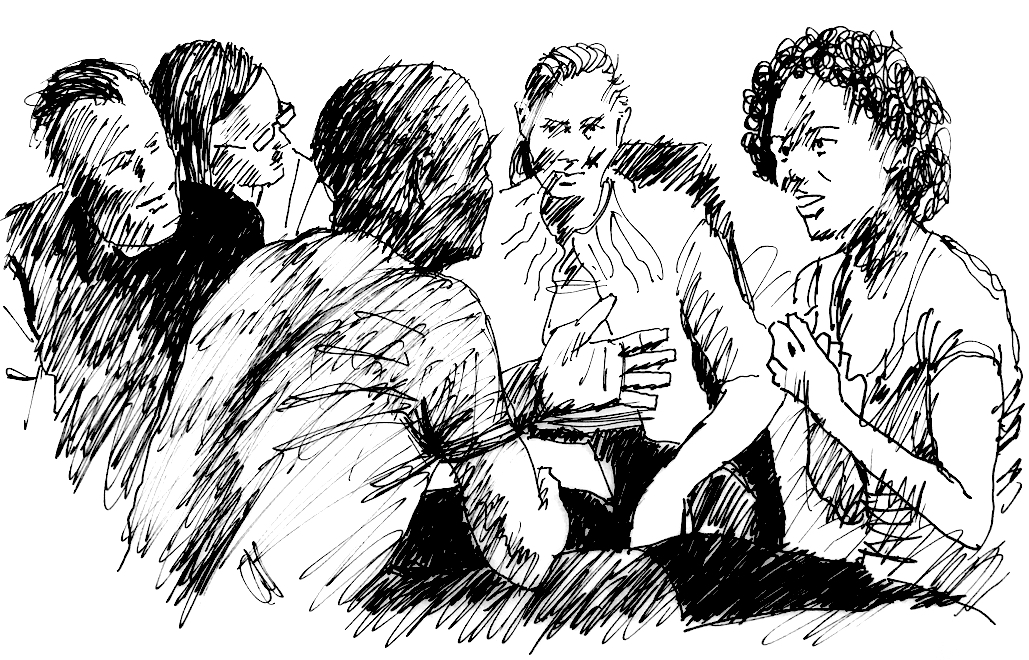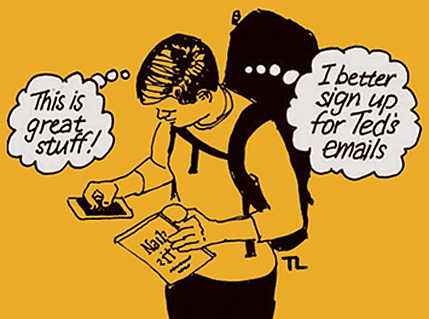Why a creative co-op?

Why not just start another creative services firm and put a bunch of freelancers on the payroll? Actually, I’ve done that. And yes, I made a good living building a traditional brand-design firm. But times have changed. My understanding of what the right thing to do has changed. The world has changed, and I think things are out of balance.
I was in town for a gig and happened on a scene that furthered my resolve to make some changes…
The CEO’s limo arrived to the kind of acclaim that was once reserved for movie stars. Smartphones on sticks, and security looking tough; it made me sick to think that his reported income was a $100 million last year. Toping it off, he’s just closed another U.S. plant, idling thousands while opening another in Mexico.
As I watched him ascend the stairs of the grand hotel’s showy main entrance, the entry reserved for political photo ops, I thought about the branding we’d done for him that, sadly, contributed to his personal wealth.
Time for change
Over the last 10 years or so I’ve watched conditions emerge that I believe favor forming a cooperative group of like-minded creatives who would enjoy working together, meeting the needs of clients that are focused on making the world a better place.
-Creatives are uncomfortable with many corporate practices – greed and degradation of the environment being tops on the list.
-There are thousands of freelance creatives who are underpaid, underappreciated and disconnected.
-The number of independent design and ad shops is shrinking.
-The growth of in-house creative groups is not sufficient to employ all the talent that’s available.
-The digital revolution provides opportunities for creatives who are eager to try new technologies.
What’s happening?
Many design firms and ad agencies that were once thriving, highly creative independent businesses have been acquired by holding companies – Omnicom, WPP, et al. – and have lost their independent thinking in the process. Forced to meet the financial targets imposed by their new owners, they’re no longer able to pursue work other than large, mainstream corporate ventures. Worse, the pressure to produce revenue isn’t just on the shoulders of managers and executives; it has become part of the daily discussion. Not a motivating topic for creatives.
Holding companies turn creatives into financial instruments, and trade them in the financial market like mass-market commodities. I learned this firsthand after The Leonhardt Group was acquired by Cordiant Communications, and then working as president of Anthem Worldwide, a creative branding and packaging design agency. The “company” goal was never to do great interesting work – only to make money. So it’s no surprise that mass-market advertising and design services became commoditized as well.
Traditional methods of reaching and convincing people to buy are also changing. Surveys show that millennials and Gen-Zers don’t buy brands. That’s certainly not surprising, as the internet, private-label and store brands provide alternatives that cost less and work fine. The availability of alternatives to the formerly all-powerful national and global brands allows people to protest corporate practices and ridiculous levels of CEO pay with their purchasing power. People, especially young people, are buying based on their personal values.
Changes in buying habits, along with the digital revolution, have put tremendous financial pressure on large corporate clients, forcing them to cut costs to maintain profitability. The fees for traditional creative services have been reduced in the process. Those fees were the source of significant revenue from major product-design, advertising, branding and other creative projects that creative ad and design firms depended on.
Informed by Apple’s success as a design-driven organization, and to reduce costs, major corporations are building large in-house creative groups. IBM now has 15,000 designers on staff. Amazon, Capital One, Vanguard, Microsoft, Starbucks and many others are building large in-house groups, often paying significantly larger salaries than the agencies or other creative-service companies can pay, furthering the financial pressure on creative groups.
The digital revolution, online advertising, social media and, of course, the dominance of Facebook, Google, Apple, Adobe, Amazon, Etsy, YouTube and others have completely changed the nature of how creatives conceive and create products, entertainment and communications. The old way – a mass market that mass communications appealed to – is changing to a fragmented market that values engagement most of all. Think cat videos. This has reduced the need for creatives doing traditional creative work to support the flow of goods and services. At the same time, new ways of reaching people to promote and sell are emerging and reshaping the marketing and product-development process. All this is in flux and not fully defined. And with the continued emergence of new technology, it may not be defined for decades.
The number of contract workers has been growing steadily. Today, somewhere around 40 percent of the U.S. workforce is best described as contract or freelance. The hiring of full-time talent by in-house groups, although significant, is not large enough to absorb the number of freelancers in the workforce. Corporations do engage thousands of contract workers. But they do so to keep their payrolls, benefit costs and obligations as low as possible, while keeping contract creatives almost in servitude.
Creative freelancers tend to be independent thinkers. Yes, they’d like to make more money and have a greater sense of security, but they like the ability to work the hours of their own choosing and for clients they can believe in. A higher purpose is often a driving force. Creatives are also overwhelmingly liberal in their politics, and concerned about corporate damage – to the world at large and to their health. They don’t feel it’s right for celebrity CEOs to make tens of millions while the company’s workers don’t share in the profits that come from their labor. So they may take the corporate job because of financial need, but they do so with a certain amount of cynicism.
Created by creatives, for creatives
A creative co-op would allow creative professionals to band together and share fairly in the results of their efforts. By combining a variety of creative skills designed to meet the needs of clients with whom they share common values, the co-op could meet client needs and provide a motivating higher purpose in the process. By using a democratic system, all members of the co-op would have a say in management.
There’s a wonderful opportunity here. We can make the money we need to support ourselves, and help the kind of clients that are making the world a better place. And we can prove that there’s a viable place in today’s working world for creative, skilled, independent people.



13 Comments
I’ve been a long time reader, and I really enjoy your take on things.
I identify with everything you’ve said in this article. I would love to be part of a creative co-op but I don’t know how to start. Any pointers?
Thanks Willow. Start by reading my first post on the creative co-op….
https://tedleonhardt.com/the-case-for-a-creative-co-op/
Then start reading about co-ops. Get a copy of Nathan Schneider’s book, “Everything for Everyone.” Google him and read and listen to his interviews.
Then think about what you’d contribute to a cooperative venture and what you’d like to get in return.
And when the time comes sign up with our effort!
Ted
Ted,
Great read, timely and spot on. Having been in this industry for 3 decades it’s sad to see more disconnected corporate goals which focus solely on the money. It’s becoming crystal clear that people and the planet need more than that. Choosing to lend my experience and talent to causes that matter is moving front and center, my desire to make a difference has always been a part of my nature, but it’s growing. And, of course, I still need to make a living. I think you’re on to something, creative people have been, and always will be, the problem solvers, keep talking!
Thanks Lori!
Be sure to read my first post on the co-op idea, if you haven’t already…
https://tedleonhardt.com/the-case-for-a-creative-co-op/
And please send me your ideas on how you’d like to see a creative co-op work for you and what you’d feel you’d contribute.
Ted
Legion M is a fan-based effort to invest in and contribute to better media choices and perhaps control of media products by creating content for small and large screen outlets. They invested in Academy Award winning The Shape of Water when it was in production. This is an idea I support and Media production is both INFLUENTIAL to help society change values, focus and behaviors. All are ESSENTIAL to the survival of our species.
People can invest with Legion M for modest amounts through CrowdFunder.
Are you thinking of forming and investment group with this email? I would support that if we could sponsor productions that would appeal to mainstream media and help model a just and sustainable future. WHAT ELSE is more important?
A just and sustainable future is a core value of every creative I know. To me a creative co-op is an investment us creatives ourselves and the community we support. So, I guess yes we are sponsors of and investors in quality for mainstream media.
Hi Ted, Thanks for the post. I have always avoided the idea of becoming an employer and while I have done cooperative work with others on an ad hoc basis, would be very interested in exploring it more concretely. Would you consider an international cooperative? (I’m formerly from Seattle, now in the UK.)
Tory
Thanks Tory, yes I believe that an international co-op is the only way to go. What took you to the UK?
Great analysis of current marketplace trends and the reasons that creative solutions in corporate communications, for the most part, have been replaced by the obvious and the ordinary.
I read both posts on this subject, and think that a creative co-op is a great idea. The questions that immediately come to mind are how are sales generated and who does the books–two areas of business that most creatives, including me, find unattractive to say the least.
Skills I can contribute are concept/copy, art direction, graphic design, package design and photo editing.
Looking forward to more on this.
Thanks Pat,
I’m working on a post now about how the sales could be generated. At the moment it’s titled “Show me the money.” A phrase my CFO used to say to me whenever I came up with a new idea. We’ll certainly need a bookkeeper as well as other roles to make this thing go. Thanks for your comment.
Great article and idea. I’m very interested but not sure I can make it to the meeting on Saturday. Will you have more chances to get involved?
Yes lot’s more chances to get involved. Thanks! BTW the Saturday meeting filled instantly.
I am sorry to be so slow to learn about this – and have already expressed an interest to you in email. I would like to stay informed and be involved in what transpires.
Brilliant idea for all of the right reasons.
I bring many years of design management and creative direction, am still a hands-on go-to person for all things design for a number of clients. Working out of my home. Missing the comraderie being a part of something larger with great talent!
THANKS TED. KEEP ME POSTED.